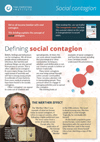
Social contagion
We’ve all become familiar with viral contagion. This briefing explains the concept of social contagion.

Emerging data supports the theory that ‘social contagion’ is behind the recent surge of gender-confusion among young people.
In an opinion piece for the Wall Street Journal, former academic Dr Colin Wright — who was hounded out of academia by trans activists for suggesting the link in 2020 — argues that growing evidence is making it “harder for anyone to deny”.
The Christian Institute has previously documented how social contagion helps to explain the transgender phenomena, especially among teens.
Wright notes activists’ claims, that “the sharp rise in transgender identification over the past decade simply reflects liberation: People today are more comfortable expressing their authentic selves”.
But he argues: “if transgender identity were an innate trait, like left-handedness, we would expect identification rates to rise at first when it became socially acceptable, then plateau and remain stable at a fixed level.
“If the phenomenon were instead driven by social contagion, we might expect a boom-and-bust pattern: a spike followed by a rapid decline once the social forces driving it weaken.”
Presenting recent statistical analyses from the Centre for Heterodox Social Science, psychologist Jean Twenge and the Society for Evidence Based Medicine, Wright concludes that “the data bolster the social-contagion hypothesis”.

We’ve all become familiar with viral contagion. This briefing explains the concept of social contagion.
He warns, however, that evidence of a post-peak fall, or at the very least a plateau in ‘trans identification’, does not mean “the transgender phenomenon will necessarily collapse”.
“It’s possible that these identities will persist, not because they reflect a long-suppressed biological condition, but because activist, scientific and medical institutions have redefined transgender to encompass virtually any degree of nonconformity to traditional sex stereotypes.”
Despite facing accusations of being “transphobic”, he explains: “The social-contagion hypothesis was never hateful. It was purely descriptive: a recognition that social and cultural factors shape human behavior.”
“The surge in transgender identification in recent years wasn’t the revelation of a hidden biological truth. It was a social phenomenon shaped by imitation, ideology and institutional reinforcement.”

This briefing argues that the concept of social contagion helps to explain the recent surge in transgenderism among young people.